St. Joseph Health joins CommonSpirit.org soon! Enjoy a seamless, patient-centered digital experience. Learn more
On Saturday, June 15, 2013-A Navasota couple welcomed babies they’d been trying to have for years. A St. Joseph team of 15 people ensured the hospital’s newest set of triplets entered the world safely.
Antonio Sanchez and Maritza Castillo had been together for 11 years. Though Maritza had never been on birth control, the couple couldn’t get pregnant. “For years, people would ask when we were going to have kids,” said Sanchez. “In their mind they were thinking that we didn’t want kids. We wouldn’t tell them the real situation.” “It was our struggle and we didn’t want to share it,” said Castillo. After being diagnosed with Polycystic Ovary Syndrome, PCOS, a hormonal disorder that often leads to infertility, the couple sought a fertility specialist. She was at work on December 13, 2012 when a nurse called to tell her she was pregnant. “All I could do was stand there and cry with happiness,” said Castillo. I was thanking God that He allowed this to happen.”
For women with PCOS, the risk of miscarriage is higher. Adding the possibility of multiples to the equation only increased the risk level for Castillo’s pregnancy. Because of this, Sanchez and Castillo kept their good news to themselves, though both believed it was only a matter of time before they would add twins to their family. At Castillo’s next appointment, they learned otherwise. “The doctor said ‘it looks like there’s going to be another one in there,’ ” said Sanchez. “I was shocked. Then it hit me and I got excited - I couldn’t stop thinking about them!”
This future family of five needed to find an obstetrician. “I kept hearing ‘you need to go to the Women’s Center, they deliver triplets,’ ” said Castillo. “That’s how I found Dr. Jansky.” In fact, triplets had been born at the St. Joseph Women’s Center just a few months earlier. Despite two recent cases, triplet births are rare. 5,153 births a year in the U.S. result in triplets, according to the Center for Disease Control’s National Vital Statistics Report. “With multiples there is always a risk of preterm labor, gestational diabetes and preeclampsia,” said Dr. Jansky. She and a perinatologist monitored Castillo and the triplets, who were now being referred to as “A,” “B” and “C.” Mother and babies had been doing great right up until 30 weeks, when Dr. Jansky detected a problem. Baby C hadn’t grown as much between visits and there was a problem with her amniotic sac. “Baby C had essentially stopped growing, there were weight discrepancies between it and the other two,” said Dr. Janksy. “The baby’s amniotic fluid was very low too, that’s a red flag that the baby is in trouble. Further complicating the situation, was triplet C’s location – underneath babies A and B. Baby C was still breathing but not moving very much. “The kidneys of the baby weren’t making urine,” said Dr. Janksy. “We were worried that the placenta had stopped feeding the baby adequately.” Dr. Jansky weighed the risks against the benefits of keeping the triplets in the womb. “Making it to 30 weeks with triplets is great for them. While the other two were doing fine, we were worried about baby C,” said Dr. Janksy. “I believe it was going to die if the pregnancy continued without intervention.” Dr. Jansky decided to deliver in two days; time the babies would need to finish developing. Castillo was given an antenatal steroid injection. Antenatal steroids help reduce the risk of respiratory distress syndrome, RDS, in preterm deliveries. “The hope was that the steroids would help the babies’ lungs mature and be ready to exchange oxygen outside the womb,” said Jansky. Friday, Castillo checked into the Women’s Center at St. Joseph and received another dose of steroids. Dr. Jansky prepped her team for delivery the next day. These babies, all in breach position, were coming.
On the morning she would meet her three new babies, Castillo recalls being surprisingly calm. “I was really relaxed,” said Castillo. “All the nurses were very, very supportive. They put me at ease.” Even her anesthesiologist was encouraging. “She had just had a complicated pregnancy and knew what I was thinking,” said Castillo. “She knew what to say.” “Everyone there just motivated us to not be scared,” added Sanchez. “I loved the way they just took care of us.” That morning, there were plenty of sources of encouragement in the delivery room; a team of specialists was waiting to care for these preemies. “There were three or four people for each baby. So 10 or 15 people and they were all ready and excited for those babies to come out,” said Sanchez. The triplets’ welcoming committee included a respiratory therapist for each newborn, three neonatal nurses, a neonatologist, a neonatal nurse practitioner and Dr. Jansky. All would ensure the triplets arrived safely. “When I saw everyone in there, I knew they had it under control,” said Sanchez. Before long, they heard the first cry. “Then that’s when I started crying,” said Castillo, tearing up as she recalled the day. “They’ve been inside you and you haven’t been able to see them but you’ve wanted the best for them, and now here they are, their eyes are open and crying.” “When I saw her get emotional, I got emotional too,” said Sanchez. Dr. Jansky delivered each triplet then entrusted the baby to its neonatal team. “I was concerned more with hearing them breathing and screaming and as I was presenting them it was secondary to think about whether it was a boy or a girl,” said Dr. Janksy. “I just wanted them to all be healthy.” The triplets stabilized quickly. Triplets A, B and C became Alana Avelyn, Marc Antonio and Mia Elizabeth and weighed in at 3 lbs, 3.5 lbs and 2 lbs 10 ounces. All were at least 15-inches long and all could breathe on their own. Three days later, the exhilaration of that moment is still visible on their proud father’s face. “I was so excited, I got a feeling I never felt before,” said Sanchez. “I never felt so excited like that before in my life! The first time being a dad, got to experience this – not just one, three at one time.” “Even if you videotape it, you could never ever relive that moment again,” said Castillo. “We thank God every day that He allowed us to have babies and that He gave us three. “Dr. Jansky did such a great job,” said Castillo. “We’re grateful for her.”
The babies are three days old today and Castillo and Sanchez will get to hold them for the first time. They walk together from the postpartum area of the St. Joseph Women’s Center to the Neonatal Intensive Care Unit, or NICU. After a stop in a small room with a hand-washing station, a short hallway leads to the NICU nursery. The babies look so cozy and sleepy swaddled in their isolettes. It’s soothing just to be in the room. Triplets Marc and Alana are across from each other. Baby Mia is a few feet away, visible through a large glass window and open door. She has her own room. Their parents have been here to visit them steadily since they were born. Women’s Center Director, Karen Boone, RN, explained the theory behind NICU nursery care: “We always let the parents touch and talk to them because those are the voices they know,” said Boone. “Once they get over the critical stage, we encourage a lot of interaction between the parents. “NICU Babies do better and grow better in an environment that mimics the womb, so we keep the lights dim and sound muffled. Especially when they’re really little, there is minimal stimulation so they can expend all of their calories growing.” Castillo sits down next to Marc’s isolette. Sanchez brushes his fingers through his son’s hair. "Their little heads are about the size of my hand,” says Sanchez, thinking out loud
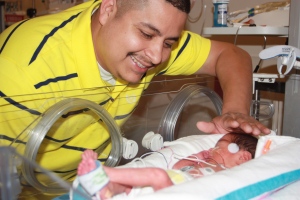
“If he could sleep in their isolettes with them, he’d be in there right now,” says Castillo. “He’s been over here more than I have really, because he can just get up and go.” Nurse Brittany Krolczyk, RN, carefully hands all three-and-a-half-pounds of Marc to his mom.
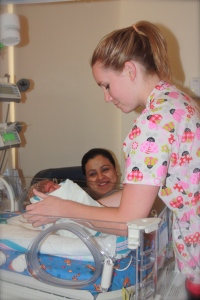
The weight of this moment – holding her son for the first time, is not lost on Castillo. “Hi baby,” she says, choking back tears. Marc responds with a coo. “It’s your daddy,” says Antonio. Before long, he is gingerly holding his son and tearing up too. A few feet away,
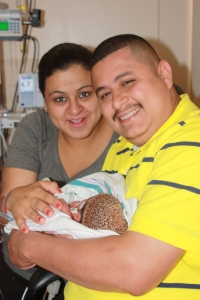
NICU nurse, Brittany Krolczyk, RN is tending to baby Mia, the smallest of the triplets and the one Dr. Jansky was originally concerned about. “Right now she’s under phototherapy and wearing these protective glasses, but when she’s off the phototherapy we keep everything quiet and dark. She’s small so she’s in this room by herself so nothing will disturb her,” says Krolczyk. The triplets were originally due August 19. They came June 15. “They still have to gain enough fat to maintain their temperature and learn how to suck, swallow and breathe when they’re trying to eat,” says Krolczyk. “They’re here until they can learn to do that and then they’ll go home.”

Krolczyk usually tells parents to expect to take their preemie babies home closer to their original due date, but finds that most don’t have to stay that long. Meanwhile, Sanchez and Castillo have already held Alana and are coming to say hello to Mia. Mia is sleeping propped up on her side and tummy on a specially designed baby pillow and layer of baby blankets. Wearing a small protective eye covering, she looks as if she’s lounging at the beach.
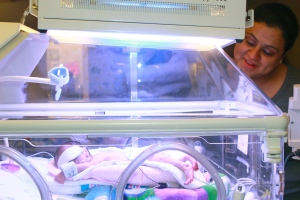
Opting not to interrupt her phototherapy, her parents lightly stroke her back and grab the perfect, tiny feet that are leisurely dangling off the back of the pillow. Castillo is being released today, so she and Sanchez will go home. They’ll both be back daily and know a NICU room for families is available overnight if they need it. “It will be hard, but we’re only 20 minutes away,” says Castillo. “Even when we leave them here, I know they’re going to be well taken care of.”
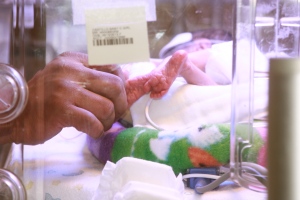
These nurses, they give them their full attention,” says Sanchez. “I can tell they love what they do.” It’s been a whirlwind three days and the couple is ready to rest at home. And still in awe of their newest blessings. “To this moment, before I go to sleep, I still think about how that feeling felt when they were being born,” says Sanchez, contentedly. “I wake up thinking I’ve got 3 babies now! Two girls and a boy. God gave us a gift and it could never be replaced with anything else.”
Publish date:
Saturday, June 15, 2013Looking for a doctor? Perform a quick search by name or browse by specialty.